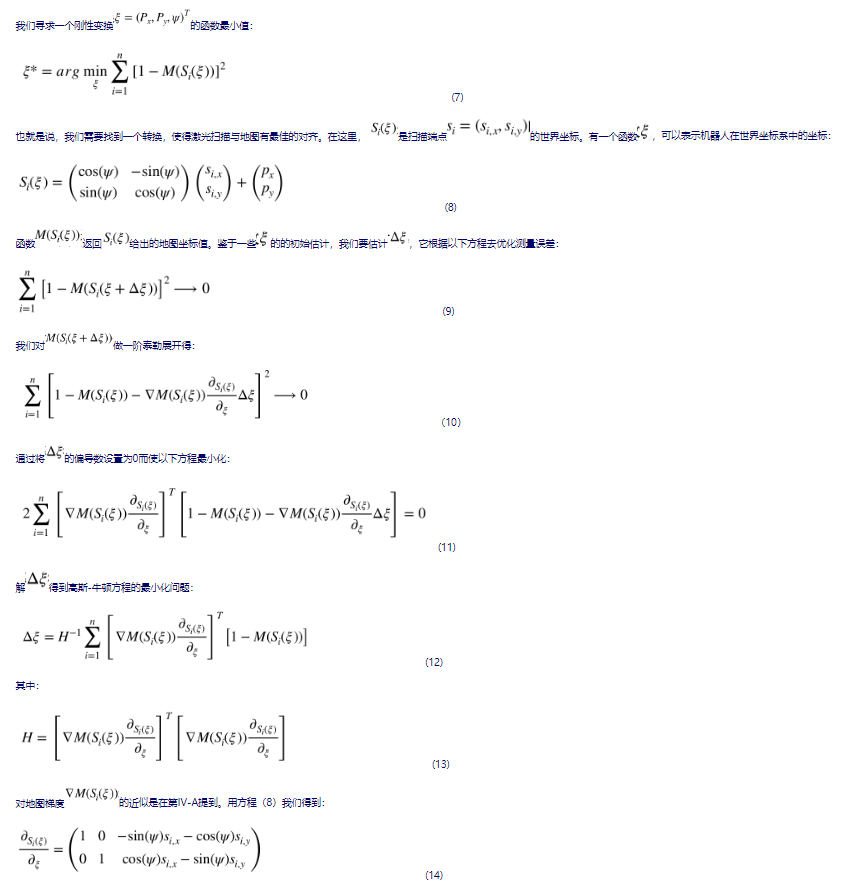参考网址:
peitianyu/lite_slam (github.com)
Hector SLAM解读(1)原文翻译 - cyberniklee - 博客园 (cnblogs.com)
ScanMatch
1
2
3
4
5
6
7
8
9
10
| 目的主要是输出激光里程计,这里使用的是scantomap
采用的数据集是r2000数据包,因此对于数据预处理比较简单,且定位精度足够
为加快速度:
- 多层地图(避免局部最优)
- 多种分辨率滤波后的激光
- 迭代残差足够小退出迭代
整体流程:
输入: pose, scan_points, grid_map(来源: 1, 建图 2, 加载)
迭代直到更新距离足够小或者超出最大迭代次数
输出: estimate_pose
|
迭代一次流程
1
2
3
4
5
6
7
8
9
10
11
12
13
14
15
16
17
18
| bool ScanToMap::EstimateTransformationOnce(const std::vector<Eigen::Vector2f> &scan_points, std::shared_ptr<GridMapUtils> map_utils, Eigen::Vector3f &estimate_in_world)
{
Eigen::Matrix3f H = Eigen::Matrix3f::Zero();
Eigen::Vector3f dTr = Eigen::Vector3f::Zero();
Eigen::Vector3f last_estimate_pose = estimate_in_world;
GetHessianDerivative(estimate_in_world, scan_points, map_utils, H, dTr);
if(H(0, 0) != 0 || H(1, 1) != 0)
{
Eigen::Vector3f d_pose_in_map = H.inverse() * dTr;
UpdateEstimatedPose(map_utils, estimate_in_world, d_pose_in_map);
}
if(PoseDiffSmallerThan(last_estimate_pose, estimate_in_world)) return true;
return false;
}
|
对于scantomap理解
1
2
3
| 1. 通过scan_point与grid_map匹配构建最小二乘,通过高斯牛顿求解
2. 由于求解时发现grid_map是离散的需要线性化,所以进行双线性插补,得到线性化后map,即▽map
3. 由于匹配时间过长以及担心局部最优,进行多分辨率地图设计
|
公式推导

代码体现
1
2
3
4
5
6
7
8
9
10
11
12
13
14
15
16
17
18
19
20
21
22
23
24
25
26
27
28
29
30
31
32
33
34
35
36
37
38
39
40
41
42
43
44
45
46
47
48
49
50
51
52
53
| void ScanToMap::GetHessianDerivative(const Eigen::Vector3f &robot_in_world, const std::vector<Eigen::Vector2f> &scan_point,
std::shared_ptr<GridMapUtils> map_utils, Eigen::Matrix3f &H, Eigen::Vector3f &dTr)
{
float ss = sin(robot_in_world(2));
float cs = cos(robot_in_world(2));
for(uint i = 0; i < scan_point.size(); i++)
{
Eigen::Vector2f point_in_scaled_laser = map_utils->LaserInScaledLaser(scan_point[i]);
Eigen::Vector2f point_in_world = map_utils->LaserPointToWorld(scan_point[i], robot_in_world);
Eigen::Vector2f point_in_map = map_utils->WorldToMapFloat(point_in_world);
Eigen::Vector3f interpolated_value = BilinearInterpolationWithDerivative(point_in_map, map_utils);
float func_val = 1 - interpolated_value(0);
dTr(0) += func_val * interpolated_value(1);
dTr(1) += func_val * interpolated_value(2);
float rot_deriv = (interpolated_value(1) * (-ss * point_in_scaled_laser(0) - cs * point_in_scaled_laser(1)) +
interpolated_value(2) * (cs * point_in_scaled_laser(0) - ss * point_in_scaled_laser(1)));
dTr(2) += rot_deriv * func_val;
H(0, 0) += interpolated_value(1) * interpolated_value(1);
H(1, 1) += interpolated_value(2) * interpolated_value(2);
H(2, 2) += rot_deriv * rot_deriv;
H(0, 1) += interpolated_value(1) * interpolated_value(2);
H(0, 2) += interpolated_value(1) * rot_deriv;
H(1, 2) += interpolated_value(2) * rot_deriv;
}
H(1, 0) = H(0, 1);
H(2, 0) = H(0, 2);
H(2, 1) = H(1, 2);
}
Eigen::Vector3f ScanToMap::BilinearInterpolationWithDerivative(const Eigen::Vector2f &point_in_map, std::shared_ptr<GridMapUtils> map_utils) const
{
float factor0 = point_in_map(0) - floor(point_in_map(0));
float factor1 = point_in_map(1) - floor(point_in_map(1));
float factor0_inv = 1 - factor0;
float factor1_inv = 1 - factor1;
float p00 = map_utils->GetCellProb(point_in_map.cast<int>());
float p01 = map_utils->GetCellProb(point_in_map.cast<int>() + Eigen::Vector2i(0, 1));
float p10 = map_utils->GetCellProb(point_in_map.cast<int>() + Eigen::Vector2i(1, 0));
float p11 = map_utils->GetCellProb(point_in_map.cast<int>() + Eigen::Vector2i(1, 1));
return Eigen::Vector3f(((factor1*(factor0*p11 + factor0_inv*p01)) + (factor1_inv * (factor0*p10 + factor0_inv*p00))),
( factor1 * ( p11 - p01 ) + factor1_inv * ( p10 - p00 ) ),
( factor0 * ( p11 - p10 ) + factor0_inv * ( p01 - p00 ) ));
}
|

